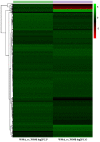Transcriptomic and Proteomic Analyses of Celery Cytoplasmic Male Sterile Line and Its Maintainer Line
- PMID: 36835607
- PMCID: PMC9967367
- DOI: 10.3390/ijms24044194
Transcriptomic and Proteomic Analyses of Celery Cytoplasmic Male Sterile Line and Its Maintainer Line
Abstract
Male sterility is a common phenomenon in the plant kingdom and based on the organelles harboring the male-sterility genes, it can be classified into the genic male sterility (GMS) and the cytoplasmic male sterility (CMS). In every generation, CMS can generate 100% male-sterile population, which is very important for the breeders to take advantage of the heterosis and for the seed producers to guarantee the seed purity. Celery is a cross-pollinated plant with the compound umbel type of inflorescence which carries hundreds of small flowers. These characteristics make CMS the only option to produce the commercial hybrid celery seeds. In this study, transcriptomic and proteomic analyses were performed to identify genes and proteins that are associated with celery CMS. A total of 1255 differentially expressed genes (DEGs) and 89 differentially expressed proteins (DEPs) were identified between the CMS and its maintainer line, then 25 genes were found to differentially expressed at both the transcript and protein levels. Ten DEGs involved in the fleece layer and outer pollen wall development were identified by Gene Ontology (GO) and Kyoto Encyclopedia of Genes and Genomes (KEGG) analyses, most of which were down-regulated in the sterile line W99A. These DEGs and DEPs were mainly enriched in the pathways of "phenylpropanoid/sporopollenin synthesis/metabolism", "energy metabolism", "redox enzyme activity" and "redox processes". Results obtained in this study laid a foundation for the future investigation of mechanisms of pollen development as well as the reasons for the CMS in celery.
Keywords: celery; cytoplasmic male sterility; proteomic analysis; transcriptomic analysis.
Conflict of interest statement
The authors declare no conflict of interest.
Figures









References
-
- Cheng Q., Wang P., Li T., Liu J., Zhang Y., Wang Y., Sun L., Shen H. Apium graveolensComplete Mitochondrial Genome Sequence and Identification of a Candidate Gene Responsible for Cytoplasmic Male Sterility in Celery (L.) Int. J. Mol. Sci. 2021;22:8584. doi: 10.3390/ijms22168584. - DOI - PMC - PubMed
-
- Schnable P.S., Wise R.P. The molecular basis of cytoplasmic male sterility and fertility restoration. Trends Plant Sci. 1998;3:175–180. doi: 10.1016/S1360-1385(98)01235-7. - DOI
MeSH terms
Substances
Grants and funding
LinkOut - more resources
Full Text Sources
Medical

